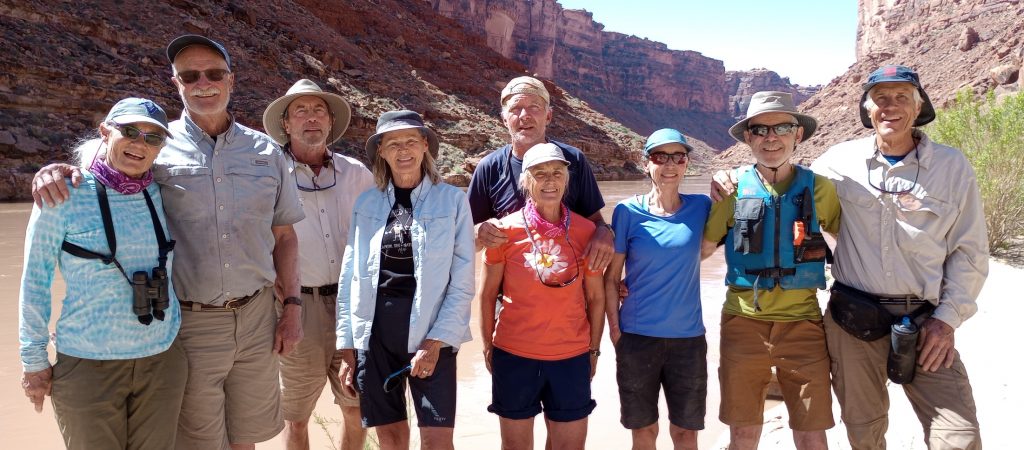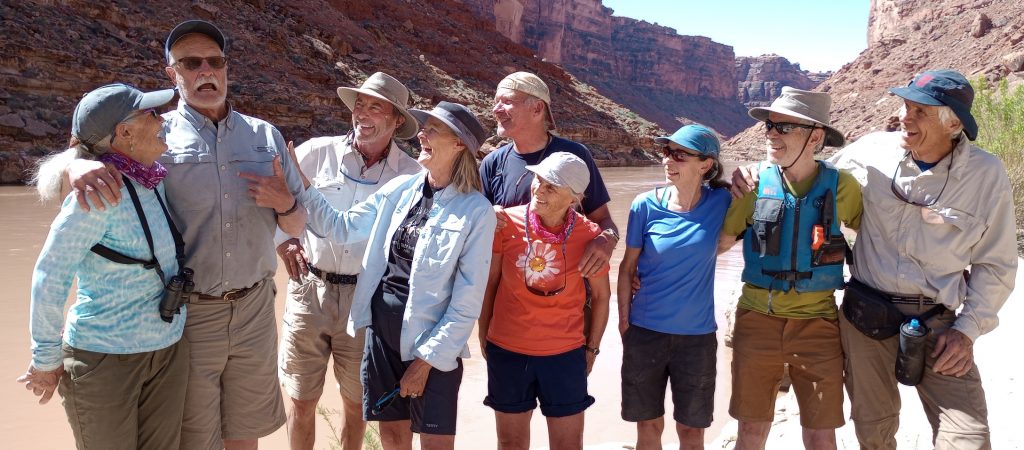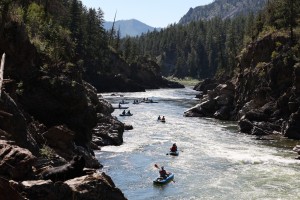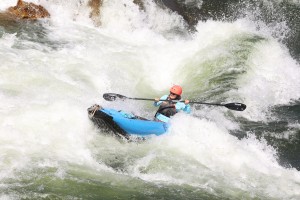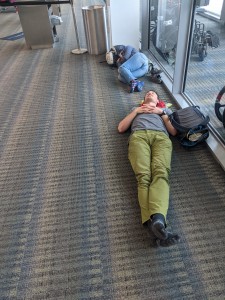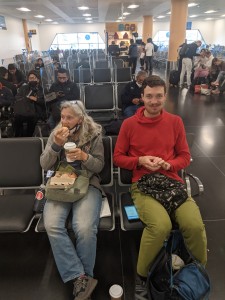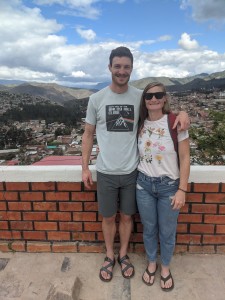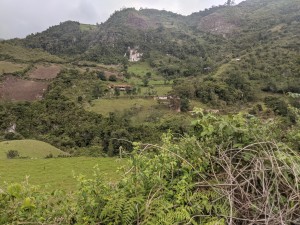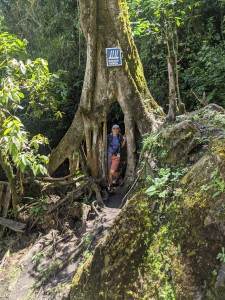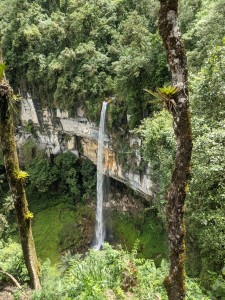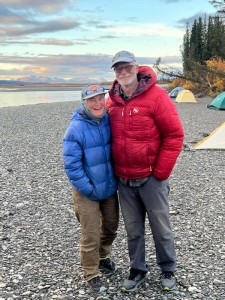There are these occasional benchmarks by which we gauge our progress through life. Reality checks. Gut checks. Ambushes. Our kids graduating from college, our enrollment in Medicare, the advent of retirement, parents passing, decades rolling past like the rhythmic click of an odometer going a tad too fast for our liking. All leading to those who-is-that-person-in-the-mirror moments.
This Memorial Day weekend was the 10th rendition of the quirky and surprising tradition of 3 Rivers, a long weekend devoted to boating three stretches of water (often notable for their ephemeral, sketchy and improbable availability) and camping out between. What started as an impulsive suggestion with no real expectation of longevity has become a fairly entrenched event that folks plan their calendars around. Participants range in age from 25 to 75 – students, contractors, doctors, artists, lawyers, teachers, nurses, guides . . . Boating skills also vary widely, although the group is quite competent in Class II – III water, and has handled some decidedly exciting moments with barbed wire, diversion dams, more whitewater than expected, less water than expected, low bridges, logjams, lethally thorny vegetation, portages. A good number of the runs have been first descents for all with surprises lurking around every bend.

The key to success and the essential ingredient to group chemistry has been the willingness to show up self-contained and prepared, ready to join in at whatever level is comfortable, and take part without complaint or protracted negotiation. Set the date, time, place and whoever comes appears, remarkably on time and fully prepared to jump into boats and head downstream. A rare group quality.
A decade ago, when this started, most of us still camped out in tents, or threw down in the backs of trucks. These days almost everyone wheels in with camper vans, trailers, slide-ins or other forms of relative comfort. A decade ago most of our kids were still in school. Now most of the kids are on some sort of career path and are behaving remarkably like adults. Some of us are grandparents now. A decade ago hardly any of the conversation was health related. These days, there’s a lot of campfire talk about prostates, joints, kidney stones, friends who have been ambushed by dire emergencies, heart surgeries and the like. So yeah, the wheels of time keep grinding along, reminding us to keep pushing the envelope while we still can.
This year was something of a departure, in several notable ways. First, we decided to extend the weekend into the following week, and recapture a sort of ‘best of’ tour of repeat rivers that stand out in the medley of 30 stretches of water we’ve enjoyed. Second, rather than taking on three different rivers, this time we ran three sections of the same river – the Stillwater River spilling out of the Beartooth Mountains and making a beautiful run to its confluence with the Yellowstone River near Columbus. Third, we were joined by Larry Laba, the founder and owner of SOAR inflatable canoes, who has bequeathed the group with a bevy of his blue boats and played a big part in our continued enjoyment of whitewater and river life. Larry showed up with two good friends, Bob and Ken, joined in for all three days, and brought SOAR tee-shirts for everyone.
This year’s weekend logistics were about as efficient as possible. The usual cadre of roughly 20 folks showed up. We camped in a riverside campground (Castle Rock) that served as the take out for the first day and the put in for the second. On the third day we all broke camp and bumped downstream for the final stint. The Stillwater, it turns out, is not at all still. It cascades out of the mountains and rips along the valley at a stout clip through bouldery stretches. We hit it before the snow came out, so we had a pretty technical, rock-garden time of it. (We ran it at roughly 1,100 cfs, but in the warm week since, it ramped up to 5,000 cfs). Day 1 took us from the picnic spot at Old Nye down to camp, roughly 10 miles of winding, pretty stream that ramped up into a hot stint of maneuvering through rocks for the last couple of miles. Day 2 was the main event, putting in at camp and engaging in pretty non-stop whitewater of a very technical nature for the entire 10 miles down to Cliff Swallow access. A lot of practice with draw and pry strokes, side-slipping, ferrying, punctuated with a few ignoble pinball descents. Then back to camp for the usual gatherings around fires, side conversations in one or another rig, drying and regrouping, taking naps. Day 3 was another 10 mile sluice from Cliff Swallow down to the Absaroka access. Not as demanding as Day 2, but plenty of action, bouncy water, quick maneuvering. All good. Seemed to me pretty clear that one of the other things that has developed over the decade is that the general whitewater skill level has amped up noticeably.

Everyone headed for home and a reset day before taking on the add-on week of rivers. On Wednesday there were 11 of us who showed up for a run down the lower section of Sixteen-Mile Creek from Maudlow to the Missouri. It’s a seldom run section of small river with a rather horrendous shuttle that winds its way though remote and panoramic ranchland, former railroad bed, wildlife-rich country (we saw elk with young calves and several moose). The river has a short window of navigability, but we got down it in style, despite a really dismal weather report (turned out to be not nearly as dire as forecast). At the end of that long day (made doubly long by the shuttle), most of us gathered at the Mavor’s for fish tacos.
Thursday was slated for Belt Creek, in central Montana. A group of 7 of us headed up. As we got close to the put in, we noticed a startling amount of newly downed timber everywhere. That spot had gotten 3-4 feet of snow and high winds the week before and was still working out of the mayhem. Our campsite was still being cleared by Forest Service crews and everyone was adamant that running the Belt was a really bad idea. Bummer.
We decided to take a hike up the lower (Sluice Boxes) section of the run as a consolation. Turned out to be a really nice hike, and along the way we were able to scout the river and actually see a raft go down. Based on new intel, we decided to stay afterall and make the run the next day. That run, from Monarch to Sluice Boxes State Park, might be the best single-day float in the state. We made our way down it on Friday, negotiating a few obstacles along the way, but generally finding it quite runnable and as awesome as ever.
Down to five now, we motored over to a campground along the Missouri River near the confluence with the Dearborn, our next destination. Lucked out with a great, riverside camp at Mid-Canon access, and got an early start the next morning for a run of the Upper Dearborn, from Bean Lake to Highway 200. That flow is unbelievably clear, running through stunning canyons and foothill country, with an occasional bigger rapid, one portage and lots of read-and-run rock garden. All in all, a very sweet day on the river.
And then there were three of us. Randy, Lee and I headed for the upper Boulder River near Basin the next morning. It was running at about 300 cfs and it looked bony as all hell. We questioned whether we could get down it without protracted hang ups, but there we were and off we went, starting near the Bernice exit, running down past Basin and the Merry Widow Mine (another story) and on to Galena Gulch campground where we left our rigs. It was really low, highly technical, but we managed to get down it without many hang ups and in somewhat breathless style. A jumpy, full-on, but very fun run back to camp.
The next morning Randy took off for home while Lee and I indulged a day off in Butte, punctuated by a memorable lunch at Mr. Hot Dogs. On the final morning of our week after, the two of us drove over to Rock Creek, west of Phillipsburg, for the last river in the line up. By this point, warming temperatures were bringing down the snowpack and the river was up to its seasonal norm, which meant it was charging along almost bank-full. We made the 16-mile run from Skalkaho Highway to the Windlass Bridge in roughly two hours, a fast charging cruise with a couple of deadfall pull-arounds, a diversion dam descent, and a side channel or two we shouldn’t have taken.
So, in the books. A reality check in just how quickly a decade slides past, a tribute to stellar group chemistry, another fun-filled slate of water, and a commitment to the next decade, wherever that takes us. 30 river sections in our wake, each memorable for its own character, a span full of comedy, hairball adventure, companionship, goofy antics, awesome moments, and zest for life. Keep bringing it on!

